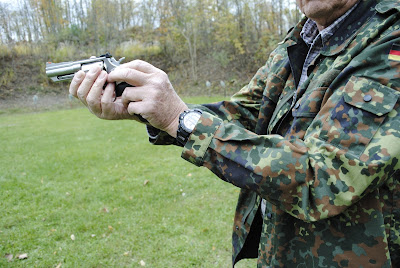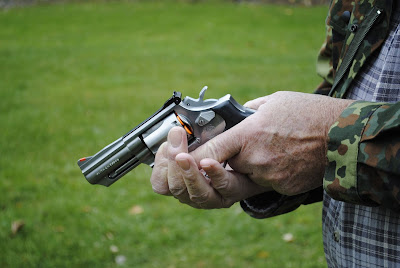Revolvers have a place in self-defense. They are easier to conceal, are not bullet configuration sensitive, less sensitive to dirt and foreign material in the mechanism and can be handed to just about anyone with a modicum of training/experience.
 |
| Mod 66 .357 mag left handed |
Reloading the revolver is the issue. The current designs were popular before speed reloads were in vogue. I don’t see a major change occurring.
Here’s the left hand reload for the revolver.
It all starts with a click when you were expecting a bang.
Pull the revolver in from the shooting position so that
your elbows are touching your body. This
takes out a degree of movement and provides a body index. Extra, unnecessary movement is the enemy of effectiveness
and therefor the fast reload.
 |
| Rest your elbows against your ribs. Two felt points of index. |
Grasp the cylinder with the right hand and push it out with your thumb while using your left fingers to press the cylinder release. This will require a slight shift of the revolver in your left hand.
Shifting my strong hand grip tp press cylinder release Note Index finger.
Grab the cylinder firmly and keep your little finger from coiling under the cylinder face where it will block the ejection of empties.
Turn the revolver, cylinder completely locked out, so the barrel
is pointing upward and the empties can fall free.
Right thumb pushed through the open frame grasping the cylinder and locking it in one location
Gravity is your friend at this moment, but some empties may be stuck in the chambers. This is likely with a dirty gun or if if you shoot .38 spl. out of a .357 magnum or similar operation with a .44 magnum. Use the heel of your left hand to run the ejector rod. Yes, some people use their right index finger, but if it empties are lodged firmly you may not have sufficient strength to punch the now useless empties out. Under stress you may miss the end of the ejector rod. The meaty part of the palm under the thumb, aka the ‘thenar eminence,’ is broad enough so a possible near miss still gets the job done.
 |
| I'm using the meaty part of my palm under the thumb. The action is driving a empty brass round out of the cylinder, the other five fell out. I always cycle this step twice. |
During this entire process you want to keep your thumb through the open frame and wrapped with your index and social finger in a death grip around the cylinder. Dropping your gun during a reload could be a death sentence.
With the empties ejected, rotate your grip so the muzzle is
pointing downward. The old-timers would
pull two rounds out of a pocket or some variation of a dump pouch. Modern pistolcraft utilizes the speed loader.
 |
| Gun butt pressed into my stomach for a third felt index while my strong left hand open pouch and removes speed loader |
The speed loader is typically carried in front of the revolver holster so they can be grasped by your strong hand. In this case it is your left hand. There are a variety of holders, but unless this is just a competition rig, I suggest using pouches with covers. You will want to retain the loaded speed loaders through the activities of the day or night.
 |
| I'm hold the speed loader by the release to show how I'm lining the rounds up and inserting |
 |
| Lined up and inserting... |
Grasp the speed loader by the body of the loader and not the release knob. You’ll have more control over them. Look down at what you are doing, line up the rounds with the empty chambers and insert the tip of least two rounds. Then tip the rest into the waiting chambers.
 |
| Release the rounds and... |
Drop the speed loader, it will tumble out of the way by itself
Once the rounds are partially inserted, release the lock and let the round fall into the chambers. Drop the speed loader. Don’t retain it, pick it up or pocket it. Leave it on the ground for the evidence technicians. Your only goal is to reload your revolver as efficiently as possible so you can get back into the fight if necessary.
In a perfect world, all the rounds would seat themselves. In our world, you may drop a round. Let it go! A partial load is vastly preferable to a non-operational
gun. One of more rounds may not fully
seat. Use your left thumb to push them
in place.
 |
| Finger out of trigger guard, right hand closing cylinder |
 |
| Right hand makes sure the cylinder is in battery My shooting hand is low on grip to show details. |
Move your left hand to your shooting position high on the backstrap and rotate the cylinder inward with your right hand. Give it a little click to ensure the gun is in battery.
 |
| Reload complete, now assess note finger off of trigger on frame |
Slide your right hand down the frame and grasp the weapon.
At this point you want to reassess the situation. The shooting phase could be over. Your adversary could have moved, retreated or
is attempting to flank you.
Speed loaders
There are several brands of speed loaders on the market: HKS, Pachmayr and Safariland among
others. Some, like the Safariland Comp
III are significantly larger for better grip and spring loaded. These types are
more suited to competition and are seldom used off the competition range. They are gun specific.
 |
| The two type of speed loaders I use |
 |
| Double pouch with Velcro tabs to secure speed loaders in movement |
Here too reliability is important. A reloader that doesn’t release quickly, drops rounds prematurely or requires the loader to touch the locking stud on the extractor star, like the Safariland, could create unwanted complications. Speed loaders are caliber specific to a large degree but are also dependent of your revolver.
While not a speed loader, the speed strip is faster than pulling rounds out of your pocket or sorting through a handful of rounds oriented in random directions.
 |
| Speed strip I carry five rounds for my J-frame and use the space to get a better grip |
Speed strips have the advantage that they are flat, easy to conceal and hold a variable number of rounds. The short course would be to insert two rounds and peel the strip of the partial seated rounds. One major advantage is you can load two and get back in the fight if necessary. Our data base, until recently, is based on police performance. More than one officer has won his survival by loading two and reengaging, followed by loading two more.
Rounds
Clearly tapered rounds, like round nose and cone shaped hollow points bullets will feed better. Semi-wadcutters work, but require a bit of fiddling and you are likely to drop a round. Wadcutters, well what can I say. Little oil can-like bullets are difficult if not impossible to load recreationally. Loading under stress with numb fingers sounds like an excellent way to committing suicide by criminal.
Modifications
The cylinder release may get in your way. You might discover you can reduce its shape
and size to give you a tiny amount of clearance. I suspect the better option is to practice and
modify your insertion procedure so a different revolver does not flummox you.
The same applies to grips.
Oversized wood and rubber grips are popular and can affect your
reload. Again I suggest a little
practice until you are sure that lowering a high spot or reducing the grip thickness
is called for.
Do I have to mention it?
Any modification you make in a defensive weapon must be able to be
defended in court. Any modification that
provides you with additional time to reflect and evaluate the unfolding event
is defensible.



Comments
Post a Comment